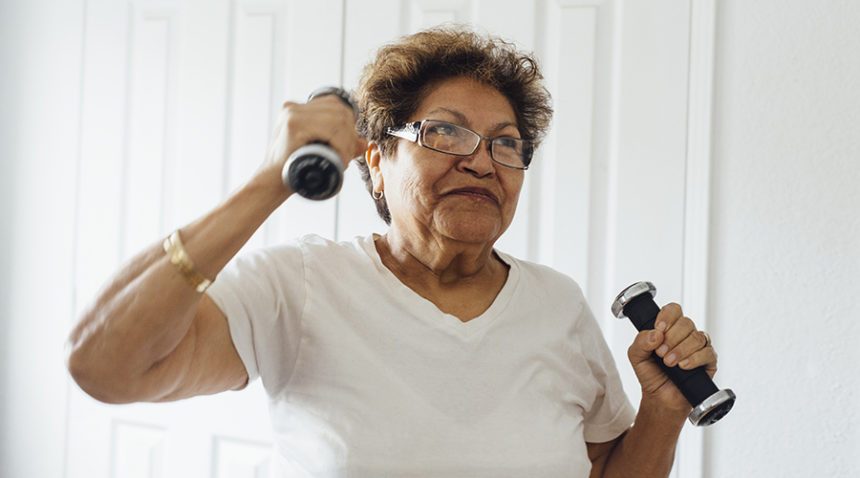Remember your first steps?
Of course you don’t—you were probably about a year old. You’ve been walking so long that you can’t remember ever not walking.
So don’t stop now. Experts say exercise and movement are among the best things you can do to maintain your health and well-being in each stage of your life, especially as you age.
“Our lifestyles have a big impact not only on our physical health but also our cognitive abilities,” says registered nurse Susan Chesser, MPH, a UNC Health educator.
Moving helps keep your blood flowing freely, bringing oxygen and nutrients to all parts of your body, she says.
Even if you don’t have access to a wellness center, a gym or a swimming pool, you can probably find a place to walk.
“As a nurse and health educator, I’ve worked with cardiologists, oncologists, neurologists and geriatricians,” Chesser says, “and I’ve been a caregiver for my mom. Every physician I’ve worked with has said that exercise is medicine. You don’t have to do anything crazy. That’s what’s so great about walking.”
Get the Most Out of Walking
If you’re not moving your body much, starting with a short, leisurely walk is great. From there, you can work up to a brisker pace and eventually add other elements, says UNC Health fitness floor trainer Colleen Foster.
“When you’re walking, you can lift one knee up like you’re marching and hold it for about three seconds,” she says. “That helps endurance and balance.”
You can walk sideways part of the time; try a resistance band stretched between your ankles or knees to strengthen muscles. Walk backward for a few steps (be careful not to trip or fall) to work your glutes and hamstrings. Use a park bench to do planks or modified pushups, and a low step or curb for step-ups. You can start with a few reps—10 step-ups, maybe—and then try 15 or 20 as you get stronger.
“Just look around,” Foster says. “You can turn your walk into challenging circuit training.”
Everyone needs exercises that get their heart rate up (aerobic) and those that make their muscles stronger (strength training), she says. Exercises should be done several times a week consistently. Avoid doing a high-intensity workout once and nothing else for days because you are too sore to move. Change your exercise routine, too—not only does the change ensure you are exercising your whole body, but it also keeps your routine more interesting.
Keep Your Body Functioning as You Age
Foster says there are four critical components to keeping your body fit for everyday life as you age, also known as functional fitness:
- Mobility: range of motion, especially important if you develop arthritis
- Balance: helps prevent falls
- Stability: strengthening ligaments, tendons and small muscles around your joints and trunk to keep your body more stable as you move
- Flexibility: range of motion exercises for muscles to help keep joints moving
These components work together to help a person move and live better.
Many exercise activities can help you work on all four. Walking is one. You also can take all kinds of classes at fitness centers, gyms, community centers and many other places, whether those involve spinning, Pilates, yoga, dancing or other aerobic movement. Swimming and water aerobics are great ways to get exercise and build your strength with minimal impact on your joints.
Exercise equipment will help you build your strength. You can also lift “weights” that you have at home: cans of food, bags of rice—anything that you are comfortable lifting.
Stability or exercise balls are useful, too. You can sit on them while using a computer or watching TV. Foster says to rock back and forth to stretch your lower back. You can also lie across the ball and lift your arms and legs—just be careful not to lose your balance.
Choosing the Right Exercise for You
“Exercise should make you feel good,” Foster says. “It should give you more energy and make you want to come back for more. Know your body’s limits. Start slow with little movements, even for just 10 minutes.”
Understand that any high-intensity exercise can be modified to low or medium intensity. Don’t feel like you need to keep up with your neighbors, partner or classmates at the gym. This is your workout.
Always get your doctor’s OK before starting an exercise program, especially if you have high blood pressure or another chronic disease, or if you are recovering from an illness or injury.
Remember to stay hydrated. You’ll want to have a water bottle with you when you are exercising. And don’t let your blood sugar level get too low so you won’t feel faint or pass out. Eat before you work out or bring a snack with you. Foster recommends a piece of fruit, cheese or a peanut butter sandwich.
Whether you’re just starting to exercise or trying to keep it up, it can help to remember your motivation. Whether you want to travel, volunteer, hike, cook, play with grandchildren or anything else, you will be able to do it more easily if you stay flexible and mobile.
To find out more about what kind of exercise is best for you, talk to your doctor or find one near you.

